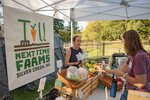
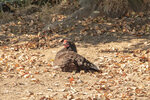
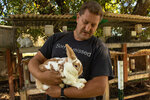
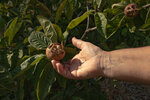
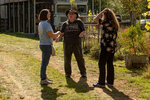
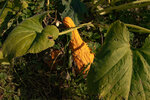
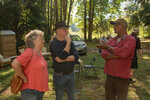
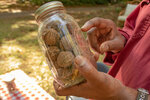
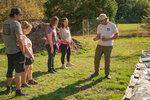

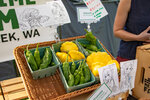
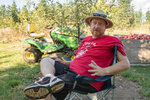
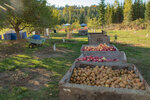
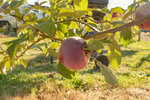
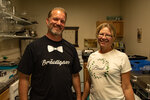

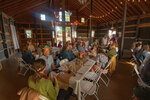
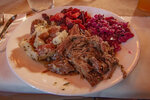
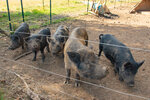
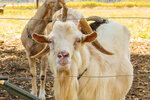
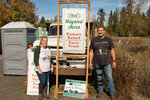
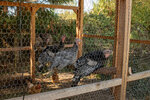

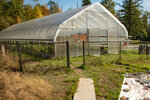
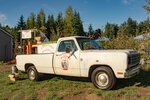
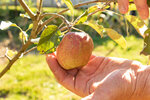
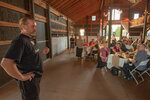


Normally, Onalaska is a quiet rural town.
But, for its 14th annual Onalaska Apple Harvest Festival last weekend, thousands flocked to the community, visiting more than 100 vendors.
The festival, put on by the Onalaska Alliance, had a plethora of events — including a parade, a pie contest and, of course, a pie-eating contest — to entertain attendees. In line with the Alliance’s goal to uplift local agritourism, Sunday offered attendees a free farming education.
Five farms in the Onalaska area participated in the festival’s farm and homestead tour as attendees learned how owners use their land, adapt their practices, and promote sustainability and self-reliance.
Following the tour, a farm-to-table dinner was held at the Mason Jar event center, catered by Jeremy Wildhaber, chef for the Chehalis restaurant Jeremy’s Farm-to-Table, and his wife, Anna.
The duo were just married at the Mason Jar the week prior.
Hayseed Acres
The first stop on the tour was Hayseed Acres, located at 1979 state Route 508 in Onalaska.
Owner Jerry McFarland raises meat rabbits and chickens, selling the meat and eggs to farm customers and local grocery stores.
Originally from northern California, McFarland has been farming in Onalaska for seven years now.
“I like it out here, it’s a nice quiet community,” McFarland said.
McFarland breeds Californian-New Zealand rabbits for the meat, and while hunters could bag their own wild hares, they run the risk of having parasites and worms in the meat.
He is also one of only two Washington State Department of Agriculture licensed rabbit meat processors throughout the entire state.
And while he does have chickens, he only has them for eggs and does not slaughter them for meat. His eggs are for sale at both the Ethel Market, located at 1421 U.S. Highway 12 in Ethel, and the Salkum Supermarket, located at 150 Salkum Road in Salkum.
Hayseed Acres is expanding as well, and McFarland is planning on adding four dozen more chickens to increase his egg production.
“I’ll be bringing those in here next month, and I’ll be doing it gradually where I’m getting more coming in over this winter so they’re starting to produce by next summer,” said McFarland.
He hopes to have a commercial processing site on his farm by next summer to be able to sell to restaurants and bigger grocery stores in Lewis County, too.
Those interested in purchasing rabbit meat or eggs can contact McFarland at 360-216-5295 or jerrymcfarland@hayseedacres.org. For more information, visit https://www.hayseedacresfarm.com or find the farm on Facebook.
LaCamas Creek Farm
With sustainability and self-reliance in mind, Laura Sweany and Joe Royce run their farm focusing on letting nothing go to waste.
Located at 122 Campbell Road in Onalaska, LaCamas Creek Farm includes a food forest, perennial herbs, bees, an orchard, cows, rabbits, chickens and turkeys.
Royce previously considered vegetarianism, but he continues to eat the meat he raises in line with his own ethics. He aims to let no part of the animal go to waste.
“That’s kind of the philosophy here, if you’re going to take somebody’s life, it better be worth it,” Royce said. “All the meat that I eat, I know how it gets made. We breed them, birth them, grow them and kill them. We make sure their lives are as high quality as possible.”
The food forest is diverse with fruits and vegetables, and with good reason, according to Sweany.
“Diversity is really key. With climate change, you get weird weather and you might lose all the harvest on the apples because the blooms happen during some crazy polar vortex,” Sweany said. “But you still have the mulberries, which bloom earlier, and you still have the pears, which bloom later.”
The chickens help fertilize and also provide pest control for the crops, which are incredibly wide-ranging and include common foods like tomatoes, apples and squash along with rare foods like the medlar.
“It’s like an ancient apple, but you have to ferment it to get it edible. It doesn’t ripen until December and it was really important during the Middle Ages to have fresh fruit with vitamin C,” said Sweany.
She wants to help people learn to grow their own food and is a part of Raintree Nursery, participating in educational videos for farmers just starting.
“There’s a steep learning curve when it comes to learning how to grow food. You can waste a heck of a lot of money and have nothing to show for it,” Sweany said.
To view Sweany’s videos on farming practices, visit https://raintreenursery.com/pages/video-landing-page. She also runs her own personal gardening consulting business called Always Growing Design.
For more information on Always Growing Design, visit https://www.alwaysgrowingdesign.com/.
Sweany can be contacted at 360-880-2424 or alwaysgrowingdesign@gmail.com.
Shady Grove Orchards
With one of the larger farms on the tour, Harry Bhagwandin runs the Shady Grove Orchards, located at 183 Shady Grove Road in Onalaska.
Bhagwandin practices sustainable forestry and has organic orchards, gardens and a greenhouse with nursery stock for sale and woodland trails to explore. His forest isn’t a traditional tree farm though filled with alders, firs, cedars and spruces.
“It’s more of an Eastern deciduous forest where you have nut producing native forest hardwood trees,” Bhagwandin said. “In the Pacific Northwest, our dominant tree is not an edible nut producing tree.”
Bhagwandin is originally from the Midwest, where the forests are full of black walnut, hickory nut, hazelnut, chestnut trees and more. He wants to treat trees as a cropping plant, not just timber, and believes there are many advantages to doing this.
“I can plant a tree and it feeds multiple generations, whereas I can plant corn and keep having to plant it every year,” said Bhagwandin.
He’s found varieties of nut-producing trees suited to Washington’s climate, including gathering seed stock from his neighbors who already had trees growing. The wood produced by some of these nut-producing trees is also highly sought after.
“The Pacific Northwest timber industry is based on conifers, and we can grow trees better than anywhere else in the country. Why aren’t we growing black walnuts and chestnuts and hickory nuts and oak, for lumber, when we can grow them better than we could elsewhere?” said Bhagwandin.
Much of the wood produced by these trees is highly valuable too, and one particular walnut variety he grows produces on average 20 nuts per pound during harvest season. Aside from the trees, Bhagwandin also has a greenhouse with vegetables and seedlings.
His family runs Shady Grove Rejuvenation on the farm, which offers a variety of therapeutic massage services. For more information, visit https://shadygrove.massagetherapy.com/home.
Till Next Time Farms
Featuring greenhouses filled with vegetables and fruit along with chickens, Till Next Time Farms is located at 717 Schoen Road in Silver Creek.
It is owned by Devin Gustafson, Ashleigh Perelli-Minetti and Grant and Sarah Bartlett, who raise chickens and run a high-efficiency market-garden farm using restorative agriculture practices to produce healthy vegetables.
Currently, they have one greenhouse set up and are preparing grounds on their farm for two more according to Gustafson. Using soil solarization, they get the new greenhouse grounds ready by purging the soil of many disease-causing pathogens, nematodes and weed seeds and seedlings.
Solarization involves covering the ground with plastic during the summer to heat and purge the soil without chemicals or pesticides.
“Next spring, when I’m ready to use this, I will pull off all the plastic and I will do the one till I do for a new bed. We don’t till regularly, that’s why our farm is ‘Till Next Time,’ we’re doing regenerative no-till farming as much as possible,” Gustafson said.
The chickens they raise aren’t just for meat and help take care of the farmland.
“When you do pasture raised poultry, it makes green runways on the field, it makes better grass and better crops by putting chickens on it,” said Gustafson.
Kept in a movable cage called a “poultry cart” to protect them from predators, the chickens live their lives out on the pastures on Till Next Time Farms before being slaughtered.
To order chicken, visit https://tillnexttime.farm or find the farm at the Chehalis Farmers Market, which is open every Tuesday from June through October in downtown Chehalis. To get in contact with the farm, find it on Facebook or Instagram or call 214-577-2432.
3 Dog Cider and Brewstillery
The final stop on the farm and homestead tour was the 3 Dog Cider and Brewstillery, located at 1402 state Route 122 in Silver Creek and owned by Joshua Hail.
Hail participates in the Lost Apple Project to grow long-lost apple varieties and presses and ferments fresh ciders on site. Currently, he is growing more than 40 apple varieties on his pastures.
“Our oldest apple tree, we’ve had since ’78,” Hail said.
Before collecting different apples, he collected rare orchids, so when he started collecting apples it was only natural he sought out rare varieties.
While born and raised here in Lewis County, he was bitten by the “apple bug” when he moved to New York for school.
“I toured a lot of breweries and distilleries while I was over there, anywhere from Virginia and North Carolina up to Massachusetts,” said Hail.
Many of his varieties are sourced from the foothills of the Appalachian Mountains in North Carolina, as the region is good for growing apples.
“There’s a lot of lost varieties there from the old homesteads,” Hail said.
Originally, there were more than 22,000 varieties of apples according to Hail, and now there are approximately 14,000. He wants to help bring back some of the older varieties as many of them last longer than store-bought ones.
Some of the lost apple varieties he is currently growing include Ivanhoe, Shackleford and streak Pippin among others, including one that was known as Thomas Jefferson’s favorite variety, Esopus Spitzenburg.
“It’s from Esopus, New York, from the late 1700s or early 1800s,” Hail said.
Growing his own apples is also helping him develop his own homegrown natural yeast, which he uses in his cider’s fermentation process.
“Once you get an apple orchard going and you’re fermenting there and the yeast has been multiplying and maybe getting dumped out, your orchard will start to create its own native yeast,” said Hail.
While Hail still presses and ferments cider at his farm, he has just purchased a new location along U.S. Highway 12 he intends to use for cider processing and sampling once renovations are complete.
For more information, visit https://3dogcider.com/.